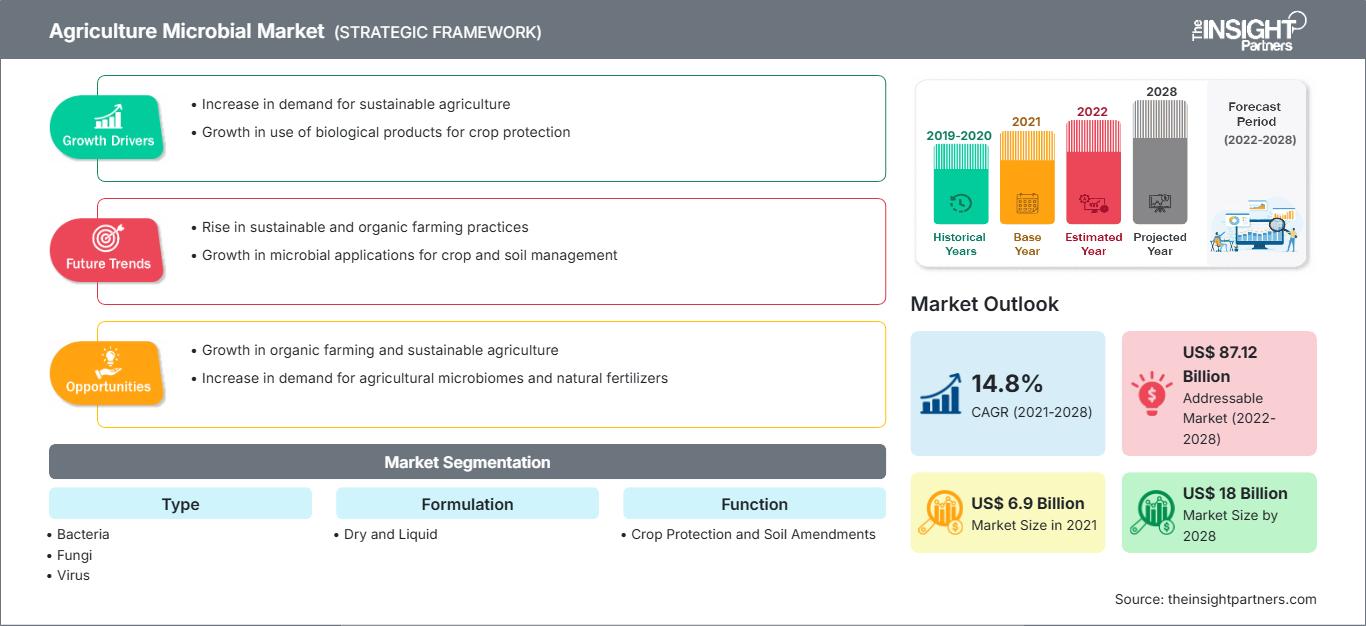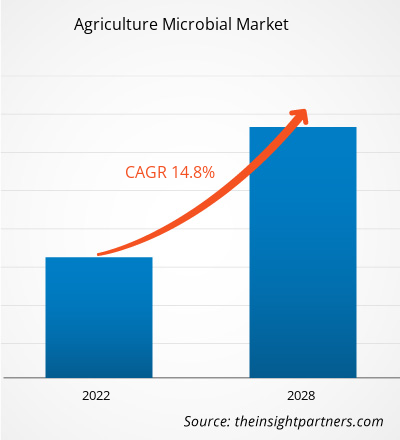Il mercato dei prodotti microbici per l'agricoltura è stato valutato 6.901,93 milioni di dollari nel 2021 e si stima che crescerà a un CAGR del 14,8% dal 2022 al 2028, afferma The Insight Partners
Il termine "microbico agricolo" si riferisce ai microrganismi utilizzati in agricoltura per migliorare la produttività e la qualità delle colture. Batteri, funghi e virus sono alcuni dei microbi. Possono stimolare la crescita delle piante migliorando l'accesso agli integratori. Molti microbi aiutano a decomporre la materia organica e a riciclare i materiali di scarto agricoli. Inoltre, forniscono fosforo, azoto e altri nutrienti e offrono benefici, tra cui la tolleranza al calore e alla siccità e la resistenza a insetti e malattie delle piante.
Nel 2020, il Nord America deteneva la quota maggiore del mercato globale dei prodotti microbici per l'agricoltura e si stima che l'Asia-Pacifico registrerà il CAGR più elevato durante il periodo di previsione. Il Nord America è una delle regioni più significative per il mercato, grazie alla crescente consapevolezza dei vantaggi dell'uso di prodotti microbici in agricoltura rispetto ai prodotti chimici di sintesi. L'uso di prodotti chimici di sintesi diventa inefficace poiché sviluppano resistenza ai parassiti e danneggiano la produzione agricola. I prodotti microbici per l'agricoltura sono pratici e rapidi da decomporre anche se applicati in piccole quantità, il che riduce l'esposizione e previene i problemi ambientali causati dai prodotti chimici di sintesi.
Inoltre, le crescenti pratiche agricole ecocompatibili e biologiche guidano la crescita del mercato dell'agricoltura microbica. Secondo l'indagine organica del 2019 del Dipartimento dell'Agricoltura degli Stati Uniti (USDA), nel 2019 gli Stati Uniti comprendevano 16.585 aziende agricole biologiche, con un aumento del 16,7% rispetto al 2016.
Personalizza questo rapporto in base alle tue esigenze
Potrai personalizzare gratuitamente qualsiasi rapporto, comprese parti di questo rapporto, o analisi a livello di paese, pacchetto dati Excel, oltre a usufruire di grandi offerte e sconti per start-up e università
Mercato microbico agricolo: Approfondimenti strategici

-
Ottieni le principali tendenze chiave del mercato di questo rapporto.Questo campione GRATUITO includerà l'analisi dei dati, che vanno dalle tendenze di mercato alle stime e alle previsioni.
Prima della pandemia di COVID-19, il mercato dei prodotti microbici agricoli era trainato principalmente dalla crescente adozione dell'agricoltura biologica e dalla crescente domanda di agricoltura sostenibile. Tuttavia, molti settori hanno dovuto affrontare sfide senza precedenti a causa della pandemia del 2020. Il settore agricolo ha subito un declino a causa della chiusura di diverse unità produttive e dell'interruzione della catena di approvvigionamento. Tuttavia, nel 2021, diverse economie hanno ripreso le loro attività in seguito all'annuncio da parte dei governi di un allentamento delle restrizioni precedentemente imposte, con un impatto positivo sul mercato globale. Inoltre, ai produttori è stato consentito di operare a piena capacità, il che li ha aiutati a colmare il divario tra domanda e offerta. Attualmente, la situazione del mercato è di gran lunga migliore rispetto al passato. Molte nazioni sono completamente vaccinate e i produttori di prodotti microbici agricoli si stanno concentrando sull'aumento della produzione per incrementare i ricavi.
La carenza di manodopera nelle unità produttive e l'interruzione delle vendite in loco tramite distributori e rivenditori a causa dei successivi lockdown e della chiusura dei negozi hanno frenato il mercato dei prodotti microbici agricoli. Nonostante il duro colpo causato dalla pandemia di COVID-19, diverse aziende hanno segnalato un aumento della domanda di prodotti agricoli sostenibili nel settore entro la fine del 2020. Tuttavia, a causa della crescente carenza di prodotti agricoli, diversi governi hanno allentato le restrizioni sulle materie prime agricole per soddisfare la domanda di cibo.
L'aumento dell'adozione dell'agricoltura biologica stimola il mercato microbico dell'agricoltura
Negli ultimi anni, l'agricoltura biologica è stata adottata a livello globale per raggiungere la sostenibilità e ridurre l'impatto ambientale. Tra i vantaggi dell'agricoltura biologica figurano la riduzione dell'erosione del suolo, la diminuzione della lisciviazione dei nitrati nelle falde acquifere e nelle acque superficiali e l'utilizzo di rifiuti animali riciclati nelle aziende agricole. La maggiore consapevolezza dei benefici ha fatto aumentare la domanda di pratiche agricole biologiche. Secondo l'indagine biologica del 2019 condotta dal National Agricultural Statistic Service, negli Stati Uniti si è registrato un aumento del 17% delle aziende agricole biologiche certificate tra il 2016 e il 2019. Secondo l'Organizzazione delle Nazioni Unite per l'alimentazione e l'agricoltura (FAO), nel 2019 l'agricoltura biologica era praticata in 187 paesi e circa 72,3 milioni di ettari di terreni agricoli erano gestiti biologicamente. Diversi governi delle economie in via di sviluppo puntano fortemente sull'adozione dell'agricoltura biologica. I microbi in agricoltura svolgono un ruolo fondamentale nell'agricoltura biologica per la gestione del suolo, poiché non possono essere sostituiti da componenti sintetici. I microbi del suolo, inclusi batteri, funghi e virus, svolgono una funzione fondamentale nel suolo, come la scomposizione dei residui colturali, il ciclo di nutrienti essenziali come azoto e carbonio e la stimolazione della crescita delle piante. Pertanto, la crescente adozione dell'agricoltura biologica stimola la domanda di microbi in agricoltura grazie ai loro benefici in agricoltura biologica.
Approfondimenti sulle tipologie
In base alla tipologia, il mercato dei microbi in agricoltura è segmentato in batteri, funghi, virus e altri. Si prevede che il segmento dei batteri detenga la quota di mercato maggiore e il CAGR più elevato durante il periodo di previsione. I funghi sono tra i microbi essenziali del suolo per la decomposizione della materia organica e il riciclaggio dei materiali vegetali di scarto. Inoltre, svolgono funzioni essenziali legate alla dinamica dell'acqua, al ciclo dei nutrienti e alla soppressione delle malattie. Ad esempio, le ife fungine si legano fisicamente alle particelle del suolo, creando aggregati stabili, che contribuiscono ad aumentare la capacità di ritenzione idrica del suolo nelle piante e l'infiltrazione dell'acqua.
Approfondimenti sulla formulazione
In base alla formulazione, il mercato dei prodotti microbici per l'agricoltura è segmentato in secco e liquido. Si prevede che il segmento liquido detenga una quota di mercato maggiore durante il periodo di previsione, mentre si prevede che il segmento secco registri un CAGR più elevato dal 2021 al 2028. Il mercato del segmento liquido è in crescita grazie alla facilità di applicazione. La formulazione liquida dei prodotti è più pratica rispetto alla forma secca dei prodotti microbici per l'agricoltura, poiché possono essere utilizzati direttamente tramite irrigazioni, spray e bagni radicali. Inoltre, non richiedono procedure aggiuntive, come la miscelazione, il che aiuta a evitare il deterioramento e lo spreco del prodotto.
Approfondimenti sulle funzioni
In base alla funzione, il mercato dei prodotti microbici per l'agricoltura si divide in protezione delle colture e ammendanti del suolo. Il segmento della protezione delle colture ha rappresentato una quota di mercato maggiore nel 2020. I prodotti microbici per l'agricoltura possono essere utilizzati per proteggere radici, semi, frutti e altre parti delle colture. I prodotti per la protezione delle colture offrono diversi vantaggi, tra cui l'aumento della produzione su aree più piccole, la protezione dell'ambiente, una maggiore resa e un costo alimentare inferiore. Questi vantaggi hanno aumentato l'adozione di prodotti per la protezione delle colture. Il controllo microbico dei parassiti offre sicurezza ecologica e una significativa specificità del bersaglio, per cui i programmi di controllo dei parassiti sono preferiti.
Approfondimenti sulle modalità di applicazione
In base alla modalità di applicazione, il mercato dei prodotti microbici per l'agricoltura si divide in irrorazione fogliare, trattamento del suolo, trattamento delle sementi e post-raccolta. Il segmento degli spray fogliari ha rappresentato la quota di mercato maggiore nel 2020. I nutrienti applicati tramite spray fogliare vengono assorbiti più rapidamente rispetto ad altre tecniche. L'uso dello spray fogliare contribuisce a ridurre i costi di manodopera e macchinari, minimizzando così i costi di produzione delle colture. Queste tecniche agiscono come un trattamento correttivo tempestivo di carenze e malattie nelle piante.
Approfondimenti sulle tipologie di colture
In base al tipo di coltura, il mercato dei prodotti microbiologici per l'agricoltura è segmentato in cereali e granaglie, semi oleosi e legumi, frutta e verdura e altri. Il segmento di frutta e verdura ha rappresentato la quota di mercato maggiore nel 2020. La crescita del mercato per il segmento è attribuita agli elevati fattori di remunerazione associati alla coltura e alla crescente domanda di nutrienti essenziali in modo efficace. Inoltre, la crescente domanda di frutta e verdura biologica aumenta la necessità di prodotti microbiologici per l'agricoltura.
BASF SE; Bayer AG; Certis USA LLC; BioWorks; Novozymes A/S; Chr. Hansen Holding A/S.; Syngenta Group; Nufarm; Marrone Bio Innovations, Inc. e Koppert BV sono tra i principali attori del mercato dei prodotti microbici per l'agricoltura. Queste aziende puntano sul lancio di nuovi prodotti e sull'espansione geografica per soddisfare la crescente domanda dei consumatori in tutto il mondo. Vantano una presenza globale capillare, che consente loro di servire un'ampia gamma di clienti in tutto il mondo e di conseguenza di aumentare la propria quota di mercato. Questi attori del mercato si concentrano fortemente sul lancio di nuovi prodotti e sull'espansione regionale per ampliare la propria gamma di prodotti nei portafogli specializzati.
Approfondimenti regionali sul mercato microbico dell'agricoltura
Le tendenze regionali e i fattori che influenzano il mercato dei prodotti microbici per l'agricoltura durante il periodo di previsione sono stati ampiamente spiegati dagli analisti di The Insight Partners. Questa sezione illustra anche i segmenti e la geografia del mercato dei prodotti microbici per l'agricoltura in Nord America, Europa, Asia-Pacifico, Medio Oriente e Africa, America meridionale e centrale.
Ambito del rapporto sul mercato microbico dell'agricoltura
| Attributo del rapporto | Dettagli |
|---|---|
| Dimensioni del mercato in 2021 | US$ 6.9 Billion |
| Dimensioni del mercato per 2028 | US$ 18 Billion |
| CAGR globale (2021 - 2028) | 14.8% |
| Dati storici | 2019-2020 |
| Periodo di previsione | 2022-2028 |
| Segmenti coperti |
By Tipo
|
| Regioni e paesi coperti |
Nord America
|
| Leader di mercato e profili aziendali chiave |
|
Densità degli attori del mercato microbico agricolo: comprendere il suo impatto sulle dinamiche aziendali
Il mercato dei prodotti microbici per l'agricoltura è in rapida crescita, trainato dalla crescente domanda degli utenti finali, dovuta a fattori quali l'evoluzione delle preferenze dei consumatori, i progressi tecnologici e una maggiore consapevolezza dei benefici del prodotto. Con l'aumento della domanda, le aziende stanno ampliando la propria offerta, innovando per soddisfare le esigenze dei consumatori e sfruttando le tendenze emergenti, alimentando ulteriormente la crescita del mercato.

- Ottieni il Mercato microbico agricolo Panoramica dei principali attori chiave
- Tendenze progressive del settore nel mercato dei prodotti microbici agricoli per aiutare le aziende a sviluppare strategie efficaci a lungo termine
- Strategie di crescita aziendale adottate dagli operatori del mercato dei prodotti microbici agricoli nei paesi sviluppati e in via di sviluppo
- Analisi quantitativa del mercato dal 2020 al 2028
- Stima della domanda globale di indumenti da lavoro
- Analisi delle cinque forze di Porter per illustrare l'efficacia di acquirenti e fornitori nel mercato dei prodotti microbici agricoli
- Sviluppi recenti per comprendere lo scenario competitivo del mercato
- Tendenze e prospettive di mercato, nonché fattori che guidano e frenano la crescita del mercato dei prodotti microbici agricoli
- Assistenza nel processo decisionale evidenziando le strategie di mercato che sostengono l'interesse commerciale
- Dimensioni del mercato dei prodotti microbici agricoli in vari nodi
- Una panoramica dettagliata e dinamiche del settore degli indumenti da lavoro
- Dimensioni del mercato dei prodotti microbici agricoli in varie regioni con una crescita promettente opportunità
- Analisi storica (2 anni), anno base, previsione (7 anni) con CAGR
- Analisi PEST e SWOT
- Valore/volume delle dimensioni del mercato - Globale, Regionale, Nazionale
- Industria e panorama competitivo
- Set di dati Excel
Report recenti
Testimonianze
Motivo dell'acquisto
- Processo decisionale informato
- Comprensione delle dinamiche di mercato
- Analisi competitiva
- Analisi dei clienti
- Previsioni di mercato
- Mitigazione del rischio
- Pianificazione strategica
- Giustificazione degli investimenti
- Identificazione dei mercati emergenti
- Miglioramento delle strategie di marketing
- Aumento dell'efficienza operativa
- Allineamento alle tendenze normative






















 Ottieni un campione gratuito per - Mercato microbico agricolo
Ottieni un campione gratuito per - Mercato microbico agricolo